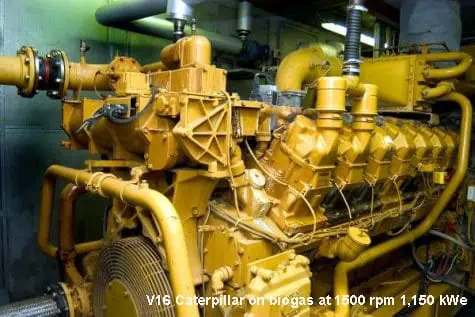Farms and biogas are an obvious fit.
Compared to many other industries, farms and biogas systems are an obvious fit. Dairy farms and other confined animal feedlots, especially larger ones, are under increasing public and regulatory pressure to manage their animal manure to control environmental problems. A significant concern is an odour, which has been a prime force behind local ordinances to control feedlot expansion. There are also potential problems with storing and spreading the manure, along with the potential for spills. Anaerobic digesters have come into their own over the last several years for their potential to address some of the environmental impacts of manure management while providing farmers with economic benefits (Nelson and Lamb).
In large-scale farms and biogas systems, the raw manure ferments in a reduced oxygen environment (heated if in colder climates). The digestion that begins in the cow’s stomach continues and is enhanced in the processor. Products of anaerobic digestion of livestock manure include a combustible gas (i.e. biogas), liquid effluent, and digested solids.
Liquid effluent is a low-odour fertiliser with characteristics closer to commercial fertilisers, providing more flexibility to farmers in land application. This by product can be a substitute for increasingly expensive commercial fertilisers. The phosphorus-rich digested solids provides bedding for cows. It also has value as soil supplements on agricultural lands or for landscapers and greenhouses (Kramer).
Anaerobic digesters
The development of anaerobic digesters for livestock manure treatment and energy production has accelerated rapidly over the past few years. Factors influencing this market demand include increased technical reliability of anaerobic digesters through the deployment of successful operating systems over the past decade, the growing concern of farm owners about environmental quality, an increasing number of states and federal programs designed to cost share in the development of these systems; and the emergence of new state energy policies designed to expand growth in reliable renewable energy and green power markets (AgSTAR Program).
Over the past fifty years, many farms have installed anaerobic digesters. When considering waste from a dairy, the most consideration is whether or not it converts dairy waste solids to gas while meeting the goals of anaerobic digestion. The objectives of dairy waste anaerobic digestion are typically:
· Reduce the mass of solids
· Minimize odours associated with the waste products
· Produce clean effluent for recycling and irrigation
· Concentrate the nutrients in a solid product for storage or export
· Generate energy
· Reduce pathogens associated with the waste

Farms and Biogas – high and low-rate processes
Generally, two processes describe dairy waste or farm biogas; high-rate and low-rate. Low-rate processes include covered lagoon digesters, plug flow digesters, and mesophilic thoroughly mixed digesters. High-rate reactors include thermophilic completely mixed digesters, anaerobic contact digesters, and hybrid contact/fixed film reactors.
Western nations have, until recently, been much less enthusiastic about farms and biogas technology than most third-world countries. The primary older style digester is labour intensive. Systems need to became mechanised and automated, so there is more uptake in the West. These automatic large-scale farm biogas plants are on the scale of town sewage plants. A downside is the capital costs which can run into millions of dollars.
Most of this section has been about large farm digesters. But medium biogas systems with volumes ranging from 50 m3 upward for cattle, pigs and poultry can still use the Chinese and Indian designs. (see the download section). Large digesters are not just the domain of farmers. Restaurant owners or collectors of food waste could construct a digester as their waste products are perfect feedstock. The containerised Green Box Biogas Plant is explicitly developed for this mid-scale market.
The Download Area documents and provides guides for project opportunities. Including selecting a gas use option and conducting site assessments. This helps identify technically appropriate and cost-effective biogas recovery processes for your farms and biogas project.
References
Kramer, 2008. Wisconsin Agricultural Biogas Casebook, https://www.build-a-biogas-plant.com Member’s Area (accessed 22 April 2010).
Nelson and Lamb, 2002. Final Report: Haubenschild Farms Anaerobic Digester, https://www.build-a-biogas-plant.com Member’s Area (accessed 22 April 2010).




Leave a Reply
You must be logged in to post a comment.